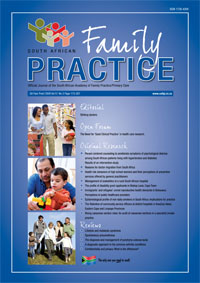The Profile of Disability Grant Applicants in Bishop Lavis, Cape Town
Keywords:
disability grant applications adults profile Bishop Lavis ICF
Abstract
Background: Disability grants in South Africa increased from 600,000 in 2000 to almost 1.3 million in 2004. This rise can be attributed to the AIDS epidemic, South Africa’s high rate of unemployment and possibly an increased awareness of constitutional rights. The Western Cape, which has a disability prevalence of 3.8%, has also experienced an influx of applications. The study was conducted at Bishop Lavis Community Health Centre in the Cape Town Metropole, Western Cape. The primary aim of this study was to establish the profile of adults applying for disability grants at Bishop Lavis. The secondary aim was the determination of the degree of activity limitation and participation restriction by means of the ICF (International Classification of Functioning, Disability and Health) shortlist of activity and participation domains. Methods: A descriptive study was conducted with emphasis on identifying and quantifying the relevant factors. The population studied included all prospective adult (18-59 year old females and 18-64 year old males) disability grant applicants in Bishop Lavis over a two month period (April - May 2007). A structured, self-compiled questionnaire was administered during face-to-face interviews with applicants. The questionnaire included the demographic details of the applicants, disability/chronic illness/condition, educational level, social/living conditions. The second part of the questionnaire was based on the ICF shortlist of activity and participation. Results: There were 69 respondents over the period of data collection. Of the 69 applicants that participated in the study, 45 (65%) received a temporary disability grant, 6 (8%) a permanent grant and 18 (26%) applications were rejected. The results demonstrate that most applicants are females over the age of 50, poorly educated with chronic medical conditions, living in formal accommodation with good basic services but with minimal or no disposable income. The ICF questionnaire responses showed that majority of respondents had no difficulty in most domains, except for the general tasks and demands (multiple tasks), mobility (lifting and carrying; fine hand use; walking) and domestic tasks domains which showed high percentages for severe to complete difficulty. However, further statistical analysis showed no association between degree of difficulty in the above domains and eventual outcome of type of grant received. Conclusions: This study confirms that unemployment and a lack of income are the factors influencing patients to seek assistance in the form of disability grants. Most applicants have a chronic medical condition and reported functional restrictions but only received a temporary grant. This may be an indication that most patients require further evaluation before a final decision can be made. There is a need for a standardised, objective assessment tool for disability grant applications. A campaign to educate patients about disability grants could save patients and hospital medical services time and money.
Published
2009-04-25
Section
Original Research
By submitting manuscripts to SAFP, authors of original articles are assigning copyright to the South African Academy of Family Physicians. Copyright of review articles are assigned to the Publisher, Medpharm Publications (Pty) Ltd, unless otherwise specified. Authors may use their own work after publication without written permission, provided they acknowledge the original source. Individuals and academic institutions may freely copy and distribute articles published in SAFP for educational and research purposes without obtaining permission.

